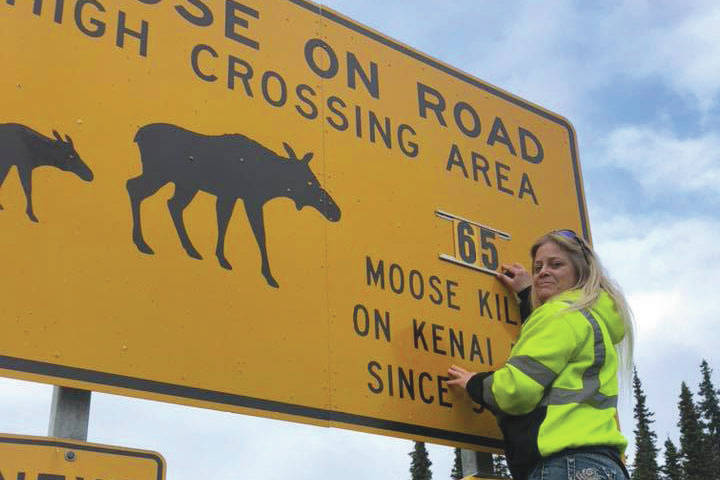As winter approaches, bringing with it shorter days and hazardous weather conditions, Alaskans are reminded to drive carefully and watch for dangers on the road — namely, grazing moose.
“Moose are dark-colored animals and, with no snow yet on the ground for contrast, seeing them at night can be next to impossible,” Alaska State Trooper Captain Rick Roberts said in an Oct. 3 post on the Troopers Facebook page.
Supervisory Fish and Wildlife Biologist for the Kenai National Wildlife Refuge John Morton said that moose tend to congregate along the roadside in the winter months for two main reasons: the roads being plowed make them easier for calves to navigate, so the cows will bring their offspring to graze, and the salts used to keep the roads from freezing provide a tasty snack.
This year, the Swan Lake Fire burned more than 160,000 acres of the Refuge, with much of that being moose habitat. Morton said that although there might be a slightly higher concentration of moose in the areas that weren’t burned, drivers should not expect any significant uptick in roadside moose sightings as a result of the blaze.
“They might struggle a little bit this winter, but there’s still plenty of food out there for them,” Morton said. “It’s not like it’s a 160,000-acre desert.”
While driving around the central Kenai Peninsula, motorists are likely to spot one of nine roadside signs that display a running tally of the number of moose killed on peninsula roadways since July 1. As of Tuesday, that number was at 65.
The signs were last updated on Oct. 10, and Laurie Speakman with the Alaska Moose Federation said that the current number is already higher — closer to 80 or 90.
Speakman and her father update the signs every three months, and she said on Tuesday that this October she has seen a higher number of roadkill incidents than normal.
“The busy months tend to be November, December, January and February,” Speakman said. “But this October I’ve done about 15 pickups myself, which comes as a surprise.”
Speakman said that not only is the number of roadkill moose higher this October, but she has also picked up an unusually high number of bull moose. All but two of her pickups this October were bulls, Speakman said.
Speakman guessed that an extended rutting season for the moose meant that bulls are still chasing the cows around — and sometimes that can mean chasing them across the road.
Speakman also noted a high concentration of pickups on the Kenai Spur Highway in between Kenai and Soldotna, something she would not have expected given the proximity to human activity and the current road construction in the area.
Speakman, known locally as “Laurie the Moose Lady,” has been picking up roadkill moose with the Alaska Moose Federation on the peninsula since 2012. Her organization helps deliver the roadkill to approved charities that process the animal and give the meat to families in need.
The process works like this: if someone hits a moose while driving, they should call 911 and report the accident immediately. As emergency vehicles respond to the scene to provide medical attention to the driver and any passengers, wildlife troopers will contact one of 37 charities on the peninsula that have signed up for the roadkill salvage program. The charities are responsible for picking up the moose, and if they do not have the equipment necessary to transport the animal they call the Alaska Moose Federation so that Speakman or one of her other drivers deliver it to them.
AMF does not have a contract with the state, and Speakman said they have to rely on donations and sponsorships from the charities to cover their expenses.
The Alaska Department of Fish and Game keeps track of the number of moose killed on the roads each year, and Wildlife Technician Kurt Strausbaugh said that Speakman and the Alaska Moose Federation are an important part of recording the roadkill data for the peninsula.
“Laurie’s a great asset to the community,” Strausbaugh said.
Fish and Game tracks the number of moose killed from July 1 to June 30. The number for 2018-2019 was 238, 232 for 2017-2018, and 262 for 2016-2017, Strausbaugh said. The average for the Kenai Peninsula is about 250 moose-vehicle collisions per year, according to Fish and Game’s website.
Advice for motoristsReduce driving speeds at night and during adverse weather conditions to allow for more reaction time should an animal run into the road.
Scan for wildlife on both sides of the road and along corridors and medians.
Look for additional animals that may cross after the first one — cows are often accompanied by calves at this time of year.
Watch for highway warning signs marking well-known moose-crossing areas.
Increase distances between vehicles to allow for greater braking distances and reaction time.
Watch for flickering headlights in oncoming traffic that may be caused by an animal crossing in front the vehicle.


